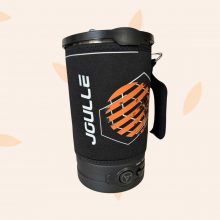- Sustainable sleeping bags made from recycled materials
- Portable Power
- Outdoor Gear
- Best for Car Camping: Mountain Hardwear Bozeman 15
- Best for Active Sleepers: North Face Eco-Trail
- Best for Cold Temperatures: Rab Solar Eco 4
- Best Backpacking: Marmot Trestles Elite Eco 20
- Best for Comfort: Big Agnes Lost Dog 0
- Best Side Sleeper: Big Agnes Lost Ranger 3-IN-1
- Important features to consider
- Environmental and sustainability organizations
- FAQs related to sustainable sleeping bags
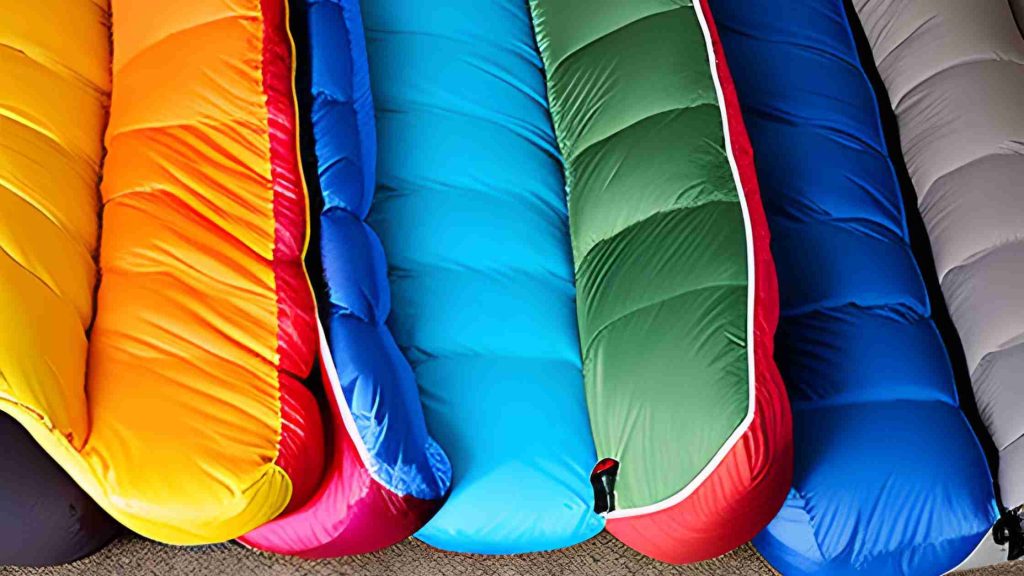
Sustainable sleeping bags made from recycled materials
A sleeping bags is one of the most important items to bring on a camping trip, especially during the winter. It keeps you warm, cozy, and comfortable when spending a night outside.
Choosing a sleeping bags made from recycled materials is an innovative way to transform waste into high-quality, long-lasting products. This helps decrease single use plastics thrown away into landfills and oceans.
We considered 5 important features when reviewing each cold weather sleeping bag:
- Temperature rating
- Sleep structure
- Insulation
- weight
- Bonus features
Fair Trade Finder makes product and service recommendations, based on thorough research and comparison analysis. Read more.
Portable Power
- Jackery vs BLUETTI: Which Portable Power Station is Right for You?
- EcoFlow vs Jackery: Which Portable Power Station Is Best for You?
- Jackery Vs Goal Zero: Which Eco-Friendly Power Source Is Right For You?
- How to choose a portable power station for home use: a comprehensive guide
- Portable Power Station Maintenance Guide: Tips & Tricks
- The Benefits of Portable Power Stations for Natural Disasters
Outdoor Gear
Best for Car Camping: Mountain Hardwear Bozeman 15
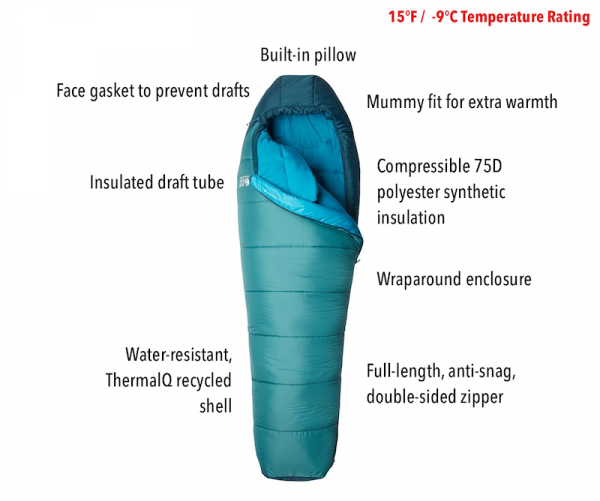
Who is the Mountain Hardwear Bozeman 15 best for?
The Bozeman 15 is a great choice for camping in temperatures of ~20F degrees and warmer.
What do customers say about the Mountain Hardwear Bozeman 15?
The Bozeman receives 4.4 out of 5 stars out of 58 customers on Google Reviews. Most reviewers praise the sleeping bag’s warmth, comfort, and spaciousness, with some stating that they were able to sleep comfortably even in very cold temperatures. Some also appreciated that the Bozeman 15 can be used by itself or attached to another sleeping bag. The main criticism is the weight of the sleeping bag, which many people feel is too heavy for backpacking.
FEATURES:
- Temperature Rating: 15 degrees (F) / -9 degrees (C)
- Shell: Water-resistant, Thermal Q recycled material
- Insulation: Synthetic, water-resistant 75D polyester synthetic insulation
- Weight: 4lb 8oz
- Maximum Height: 78 inches
PROS:
- Good thermal efficiency
- Spacious, with room to move
- Temperature regulating so you don’t get too cold or hot
- Full-length, double slider, anti-snag zipper
- Wrap-around foot box for easy ventilation throughout the night
- Insulated draft tube for extra warmth and cushioning
- Face gasket to create a barrier against cold wind.
- Can be attached to a 2nd bag
- Includes built-in pillow.
CONS:
- Some reviewers criticized the weight of the bag as being too heavy for backpacking
- Bag does not come with a compression bag
Best for Active Sleepers: North Face Eco-Trail

Who is the North Face Eco-Trail best for?
The North Face Eco-Trail is well suited for sleepers that need extra space for restless legs and arms. It’s also good for people that get hot during sleep and need ventilation. A great find for people looking for vegan friendly camping gear.
What do customers say about the North Face Eco-Trail?
The Eco Trail has an average customer rating of 4.5 out of 5 stars, out of 159 reviews on Google. Customers praise the affordability, coziness and warmth, in addition to the extended knee width and fitted cinch hood. However, a few customers noted that the bag is not as light or compact as they had hoped, and some have experienced issues with the zipper.
FEATURES:
- Temperature Rating: 20 degrees (F) / -6 degrees (C)
- Shell: 50D polyester from recycled plastic with DWR coating.
- Insulation: Synthetic, water-resistant, 50D recycled polyester insulation.
- Weight: 4 lbs. 5 oz.
- Maximum Height: 78 inches
PROS:
- Durable, rip-resistant 50D polyester
- PFC free materials
- Extended knee width adds comfort and space
- Cinch hood seals in warmth
- Wraparound J-zipper for ventilation
- Vaulted foot box adds space at the bottom
- Internal pockets to store small items like phone, wallet and keys.
- All down used in North Face products comes from the Responsible Down Standard (RDS) certified farms
CONS:
- Bulky, difficult to compress
- Some customers report issues with insulation separation and faulty zippers
Best for Cold Temperatures: Rab Solar Eco 4
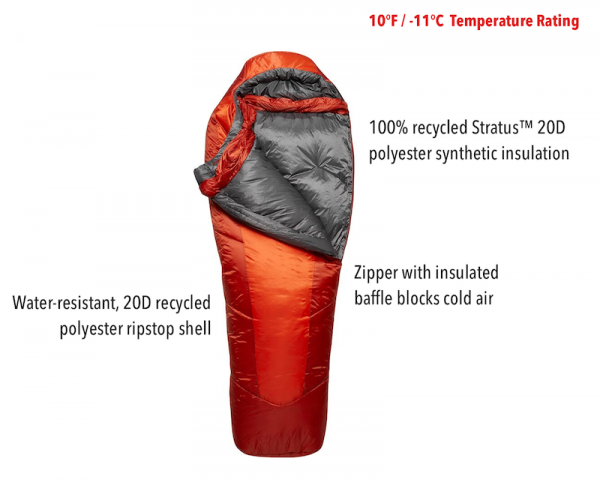
Who is the Rab Solar Eco 4 best for?
The lightweight construction of the Rab Solar Eco 4 make it great for backpacking and hiking trips. The 6.5 foot length is also comfortable for taller people
What do customers say about the Rab Solar Eco 4?
The Rab Solar Eco 4 has an average rating of 4.8 out of 5 stars on 17 customers reviews on Google Shopping. Reviewers praise the bag for its length, lightweight, sturdy zippers and warmth. The bag is well insulated up to about 30F degrees, after which the several customers began to feel the cold. Some critiqued the stuff sack that comes with the bag as being too small and flimsy.
FEATURES:
- Temperature Rating: 10 degrees (F) / -11 degrees (C)
- Shell: Water-resistant, rip-proof, 20D recycled polyester, with DWR waterproof coating
- Insulation: Synthetic, water-resistant, 20D recycled polyester
- Weight: 3lb 5oz / 52 ounces
- Maximum Height: 78.7 inches
PROS:
- Length is good for taller people
- More than 1lb lighter than other comparable bags, great for backpacking
- Plenty of room to sleep comfortably in various positions
- Cushioned for a comfortable night’s sleep
- Draft collar and drawcord hook to lock in the heat.
- Rab is a member of the Fair Wear Foundation and working to be a Net Zero company by 2030
CONS:
- Some users found the stuff sack too small and flimsy
- Some customers reported feeling cold in temperatures below 30F, which is less than the stated temperature rating
Best Backpacking: Marmot Trestles Elite Eco 20
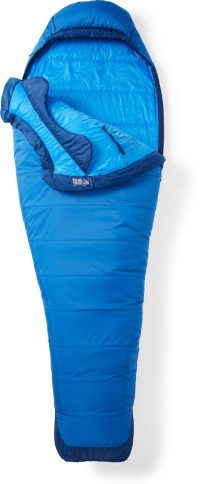
Who is the Marmot Trestles Elite Eco 20 best for?
Weighing only 1.7 pounds with a temperature rating of 20F degrees, this sleeping bag is perfect for backpacking and mountaineering trips in cold, snowy weather. The Ollan 20 sleeping bag also embodies Marmot’s dedication to environmentally responsible innovation. The ripstop shell is constructed of plant-based components derived from castor beans, synthetic materials and natural wool.
What do customers say about the Marmot Ollan 20?
The Marmot Ollan 20 receives an average rating of 4.5 out of 5 stars from 88 customer reviews on REI. Customers generally praise the sleeping bag for its warmth and comfort, as well as its use of recycled materials. Some have found it not warm enough for the temperature rating, but most have been satisfied with its performance.
FEATURES:
- Temperature Rating: 20 degrees (F) / -6 degrees (C)
- Shell: Water-resistant, rip-proof, 100% plant based Pertex Quantum nylon
- Insulation: Wool, polyester, and recycled material blend
- Weight: 1lb 7oz
- Maximum Height: 78.6 inches
PROS:
- Antisnag zipper with fold-down secondary zipper for ventilation
- 10D nylon ripstop shell is breathable and wind resistant
- 3D footbox and hood
- Lightweight, easy to pack
- Internal stash pocket
CONS:
- Some people report the sleeping bag not being as warm as the temperature rating
Best for Comfort: Big Agnes Lost Dog 0
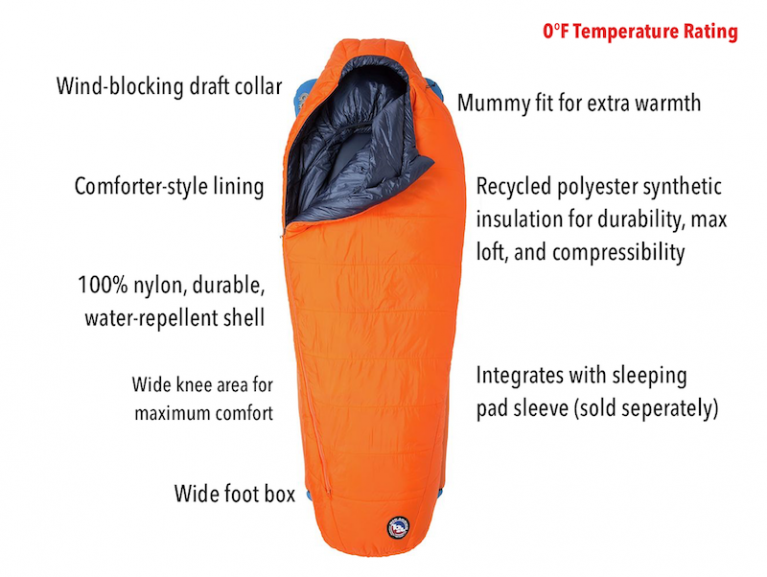
Who is the Big Agnes Lost Dog best for?
Campers who want to add a sleeping pad, taller campers, sleepers that like to move their legs.
What do customers say about the Big Agnes Lost Dog?
The sleeping bag receives 4.4 out of 5 stars out of 72 reviews on Amazon. Customers praise the comfort, length and roominess. However, some have had issues with the zipper or the fabric, and a few have expressed disappointment with the synthetic fill
FEATURES:
- Temperature Rating: 0 degrees (F) with a sleeping pad
- Shell: Water-resistant, 100% nylon.
- Insulation: Recycled polyester.
- Weight: 4lb 10oz / 2.10kg
- Maximum Height: 6 feet 6 inches
PROS:
- Draft tube, collar, adjustable hood and pillow barn seal out cold and wind
- Includes a sleeping pad sleeve to ensure the bag and pad stay connected
- Roomy and comfortable, with enough space to move around
- Free of toxic flame retardants and PFC chemicals
- Length is good for taller people
- Anti-snag zipper
- Down is sourced from Responsible Down Standard (RDS) farms
- Big Agnes won the TripSavvy 2021 Editor’s Choice Award as an industry leader in outdoor gear.
CONS:
- Synthetic fill instead of down fill, which some customers found misleading
- Fabric may be prone to tearing or damage
Best Side Sleeper: Big Agnes Lost Ranger 3-IN-1

Who is the Big Agnes Lost Ranger 3-IN-1 best for?
The Big Agnes Lost Ranger 3-IN-1 sustainable sleeping bag has a 3-in-1 modular construction consisting of two down-filled bags. The sleep system provides adjustable comfort for 3-season camping, hiking, and a wide range of activities.
What do customers say about the Big Agnes Lost Ranger 3-IN-1?
Big Agnes Lost Ranger has received 4.7 out of 5 stars out of 44 reviews on Google.
Some of the positive feedback from customers include the bag’s ability to be used as a standalone bag, a quilt, or a combination of both, and its warmth in a variety of temperatures. Customers also praise the bag’s spaciousness and hydrophobic down insulation, which makes it easier to dry out in damp conditions. However, some negatives mentioned include some people having difficulty with the bag’s zippers getting snagged, and finding the bag to be a bit heavy and bulky for backpacking.
FEATURES:
- Temperature Rating: 15 degrees (F) / -9 degrees (C)
- Shell: Water-resistant, 100% recycled polyester taffeta shell with a PFC-free DWR finish (certified by Global Recycling Standard).
- Insulation: 650-fill down insulation.
- Weight: 3 lbs. 1 oz.
- Maximum Height: 78 inches
PROS:
- The inner bag design is based on the award-winning Sidewinder sleeping bag, ideal for side sleepers
- Two 3/4-length anti-snag ambidextrous zipper
Each bag may be used independently or together
The outer bag has a draft collar, jacket-style hood, pillow barn and pad cinch system
- Makes a doublewide bag by combining two 3N1 sleeping bags
CONS:
- Some users report issues with the zippers getting snagged
- The weight may be too much for backpacking or trekking
Important features to consider
Temperature Rating: Select a temperature rating that is a little lower than the coldest temperatures you expect on your travels.
Sleep Structure: Being comfortable is dependent on a variety of factors, including the type of sleeping mat or pad you have inside the bag, if it is optimized for side sleepers and if the bag is a single or double size.
Insulation: The most important distinction in insulation is between down and synthetic. Down is preferred for dry, cold weather below 40 degrees, while synthetic is best for wet conditions warmer than 40 degrees.
Weight: This factor is influenced by many aspects, the most important of which are the quality of your insulation and the cut of your bag. When comparing weights, be sure you are comparing sleeping bags with the same temperature rating.
Bonus Features: These include unique features and accessories that will make your bag function best for you, such as the shape, whether or not it is optimized for men or women, includes internal stash compartments, sleep pad compatibility and if the materials are non toxic and vegan friendly.
Environmental and sustainability organizations
- The Renewal Workshop: https://therenewalworkshop.com/
- 4ocean: https://4ocean.com/
- The Ocean Cleanup: https://theoceancleanup.com/
- Plastic Bank: https://plasticbank.com/
- Parley for the Oceans: https://www.parley.tv/
- Terracycle: https://www.terracycle.com/
- Sustainable Apparel Coalition: https://apparelcoalition.org/
FAQs related to sustainable sleeping bags
1. What are the different types of sleeping bags?
Summer, three-season, and winter are the three primary types of sustainable sleeping bags. There are other categories, including organic and vegan friendly sleeping bags.
Visit outdoor gear company REI Co-op for tips on choosing the perfect sleeping bag.
2. What is the best material for sustainable sleeping bags?
The best quality material for wet climates over 40 degrees are recycled nylon or polyester.
Sustainable sleeping bags made of nylon or polyester and down feather insulation are ideal for dry weather and cold temperatures below 40 degrees. If you opt for down insulation, make sure its synthetic.
Sustainable sleeping bags made of nylon with synthetic insulation are best for rainy, wet weather and temperatures above 40 degrees.
3. What is a synthetic sleeping bag?
Synthetic insulation used in a traditional sleeping bag is typically made of polyester fibers, which can be made from recycled materials like PET plastic bottles.
Synthetic insulation is quick-drying and provides warmth even if wet (something feather down insulation has a hard time doing).
4. What are the benefits of synthetic insulation?
Synthetic insulation tends to be more affordable than down insulation, in addition to being durable, hypoallergenic, lightweight and water resistant.
5. Does a synthetic bag lose its warmth?
All sleeping bags lose their warmth over time. However, synthetic sleeping bags lose their warmth faster than down sleeping bags. A synthetic bag retains its temperature rating for an average of 7 years, while a down sleeping bag retains warmth for an average of 10 years. Synthetic insulation offers benefits like water resistance and affordability, but will lose warmth faster under increased compression. The life of a sleeping bag will vary depending on how often you use it and how you keep it while not in use.
6. How do you care for synthetic sustainable sleeping bags?
When not in use, let your sleeping bag air out as much as possible and allow it to dry completely before storing it. It should be stored in a cool, dry location away from direct sunlight. Do not store your synthetic sleeping bag uncompressed – it should always be compressed and placed back in its stuff sack.
Avoid cleaning your sleeping bag unless absolutely necessary. Small stains and spillages can typically be wiped up with a moist soapy cloth. Zippers should be cleaned and lubricated on a regular basis.





